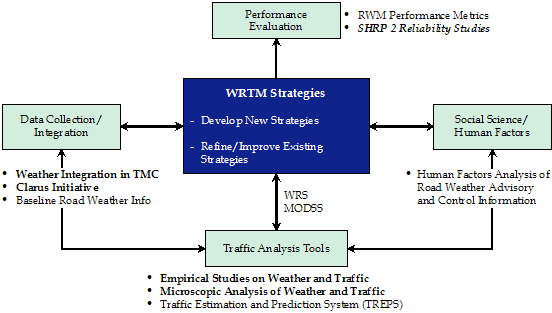Data Mining and Gap Analysis for Weather Responsive Traffic Management Studies
1.0 Introduction
During the past several years, the Federal Highway Administration’s (FHWA) Road Weather Management Program (RWMP) has carried out a series of studies to gain a better understanding of travelers’ behavior and responses to inclement weather conditions. The FHWA envisions that effective weather responsive traffic management (WRTM) strategies will be developed and implemented based on findings and recommendations generated from the efforts of last several years.
Figure 1.1 depicts the FHWA’s overall WRTM framework, consisting of ongoing activities and past efforts. At the center of the framework are the WRTM strategies that transportation agencies can implement to improve the performance of the highway system during adverse weather conditions.
Figure
1.1 Framework for Weather Responsive Traffic
Management Program

An important lesson learned from WRTM studies carried out so far is lack of relevant and sufficient traffic and weather data available for the analysis. Efforts were devoted at onset of previous WRTM studies to identify and obtain suitable data, but yielded limited results. Hence, the RWMP decided to add a task that will look into the issues related to ‘traffic and inclement weather data’.
1.1 Study Objectives
Four objectives have been identified for this project as listed below:
- Conduct a comprehensive search and documentation of traffic and weather data in the United States and abroad that could be used for WRTM;
- Establish contacts with organizations that have suitable traffic data on inclement weather, and determine procedures/requirements to obtain these data;
- Identify critical gaps in regards to the collection and processing of traffic data on inclement weather conditions; and
- Recommend strategies and generate guidelines for gathering and processing data that will be used in WRTM studies.
The remainder of this report is structured as follows.
Section 2.0 includes the findings of the literature search conducted at the beginning of the project.
Section 3.0 includes the results an analysis of traffic and weather data collected from three cities, Minneapolis‑St. Paul, Salt Lake City, and Atlanta. The process of data collection and city selection is documented as well. The purpose of the analysis was to help determine whether readily available data could be used to identify impacts of adverse weather on traffic. Assessments regarding the quality of data were made.
Section 4.0 documents the results of a web survey of Traffic Management Centers (TMC) to determine what weather and traffic data they collect, how it is used and whether they are considering implementation of weather-related traffic management strategies. Seventeen TMCs responded to the survey. This survey was supplemented with a trip to by FHWA and CS to the Utah DOT Traffic Management Center in Salt Lake City. UDOT is a national leader in the integration of weather and traffic information, and their operation represents best practice in a number of weather-related areas. This section also documents the findings of this field trip.
Section 5.0 documents the results of a web survey of domestic and international research institutions about research projects related to weather and traffic. The survey was considered important due to the fact that many research efforts have not yet been published and thus would not be available from the literature search. 39 responses were received and follow up contacts made to obtain more detail on these projects. Both the initial survey results and follow up results are documented in this section.
Section 6.0 includes a summary and recommendations.
previous | next
|

